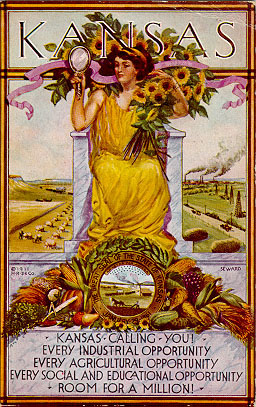 "When the cares o' day are done, on the plains o' Kansas,
"When the cares o' day are done, on the plains o' Kansas, And the kids begin to yawn, sleepy like in Kansas,
Farmer wipes his glasses blurred,
Reads a chapter o' the Word,
Then kneels down and thanks the Lord that he lives in Kansas.
-LITTLE RIVER MONITOR, November 1, 1906
As the years go by, I love the state of Kansas more and more. We have some great people living here, communities to grow a family, and many opportunities available.
I remember every year while I was a student, we would celebrate Kansas Day on January 29th by learning history, making crafts, and learning the statistics of our state. I enjoyed it when someone would bring their family's heirlooms and share stories of hard work but a simpler time.
I remember every year while I was a student, we would celebrate Kansas Day on January 29th by learning history, making crafts, and learning the statistics of our state. I enjoyed it when someone would bring their family's heirlooms and share stories of hard work but a simpler time.
As a girl, I read the Little House on the Prairie book series, and enjoyed every little bit. Laura Ingalls Wilder's family would have been in Kansas in 1869-1870 when the state was just a few years old. I remember that food and meals were a large part of the stories that were told. When I found the book that featured frontier foods from the book series, I was excited to find some pie recipes. I chose a vinegar pie to fix because I can just imagine that at the end of January their supplies were starting to dwindle and that this would have been a real treat for the typical family in the pre-1900's Kansas family.
The vinegar pie was used as substitute for a lemon pie, and sometimes referred to as the "Poor Man's Pie" because lemons were considered a luxury for people on the prairie.
When Daniel saw me put this pie on the Pie Board, he begged me not to make it. However, he warmed up to the idea and by the time I made it, he was ready to try it with an open mind. We decided that it is actually very good. The first taste does taste vinegary, but with the second taste it starts to grow on you, but then after the third bite, you start to taste the apples. While you are finishing up the slice, you can just imagine that you are eating a pie that is made from fresh fruit. It is an experience that everyone should experience and encourage you to try it out! It is definitely an economical way to enjoy a slice of pie with a fruity taste without using actual fruit.
Ingredients:
1 Pastry Pie Crust
1/4 cup Butter
2 Eggs
1/2 cup Sugar
1/2 cup Brown Sugar
1/4 cup all-purpose Flour
1/2 t. Nutmeg
3 T. Apple Cider Vinegar
1 cup water
Melt butter. Beat eggs in small bowl. In large bowl blend both sugars, flour, and nutmeg with fingers until no lumps remain. Stir in vinegar, eggs, butter, and water until well mixed. Pour into pie shell and bake for 30 minutes at 400 degrees. Remove and cool until the filling is firm enough for cutting.
You may be able to tell that I didn't get the eggs mixed the best; so I did have some spots in the pie that looked egg-y, but I don't feel that it affected the taste. I had also found some recipes that called for a teaspoon of lemon extract, and that would be good too. (edit: You may blind bake the crust if you want to ensure a crisp crust)
I also found another series of books entitled the Butter in the Well at the public library featuring stories of a Swedish immigrant to the Assaria written by Linda Hubalek. She also had a book, Egg Gravy, that featured recipes from the same time period. One of the pie recipes, "Oh-So-Good Pie", is basically a variant of the vinegar pie with an addition of 1 cup of raisins. One of the facts that Linda points out, recipes from this era are typically non-existent because they were in the cook's head, or the instructions too vague that the recipes don't turn out with our modern equipment.







I didn't blind bake my crust; however, it may help to keep your crust crisp. My cousin Phyllis suggested this.
ReplyDelete